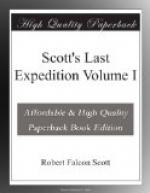Then Meares’ dogs, which were all wandering about loose, started fighting our team, and we all had to leave Scott and go and separate them, which took some time. They fixed on Noogis (I.) badly. We then hauled Scott up: it was all three of us could do—fingers a good deal frost-bitten at the end. That was all the dogs. Scott has just said that at one time he never hoped to get back the thirteen or even half of them. When he was down in the crevasse he wanted to go off exploring, but we dissuaded him. Of course it was a great opportunity. He kept on saying, ’I wonder why this is running the way it is—you expect to find them at right angles.’
Scott found inside crevasse warmer than above, but had no thermometer. It is a great wonder the whole sledge did not drop through: the inside was like the cliff of Dover.
Note 14, p. 136.—February 28. Meares and I led off with a dog team each, and leaving the Barrier we managed to negotiate the first long pressure ridge of the sea ice where the seals all lie, without much trouble—the dogs were running well and fast and we kept on the old tracks, still visible, by which we had come out in January, heading a long way out to make a wide detour round the open water off Cape Armitage, from which a very wide extent of thick black fog, ‘frost smoke’ as we call it, was rising on our right. This completely obscured our view of the open water, and the only suggestion it gave me was that the thaw pool off the Cape was much bigger than when we passed it in January and that we should probably have to make a detour of three or four miles round it to reach Hut Point instead of one or two. I still thought it was not impossible to reach Hut Point this way, so we went on, but before we had run two miles on the sea ice we noticed that we were coming on to an area broken up by fine thread-like cracks evidently quite fresh, and as I ran along by the sledge I paced them and found they curved regularly at every 30 paces, which could only mean that they were caused by a swell. This suggested to me that the thaw pool off Cape Armitage was even bigger than I thought and that we were getting on to ice which was breaking up, to flow north into it. We stopped to consider, and found that the cracks in the ice we were on were the rise and fall of a swell. Knowing that the ice might remain like this with each piece tight against the next only until the tide turned, I knew that we must get off it at once in case the tide did turn in the next half-hour, when each crack would open up into a wide lead of open water and we should find ourselves on an isolated floe. So we at once turned and went back as fast as possible to the unbroken sea ice. Obviously it was now unsafe to go round to Hut Point by Cape Armitage and we therefore made for the Gap. It was between eight and nine in the evening when we turned, and we soon came in sight of the pony party, led as we thought by Captain Scott. We were within 1/2




